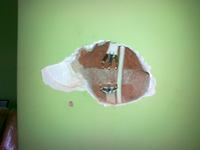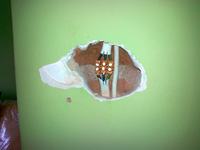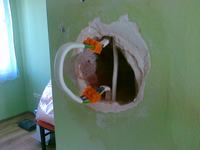Hello,
Here is the situation:
Wanting to make two small holes in the wall at the height of the lighting connectors, I found a power cord for plug sockets on the first floor (2 rooms).
When drilling, I saw only 2 sparks and automatically the drill stopped working.
It is known that there was a differential or overcurrent protection.
I went to the electrical cabinet on the ground floor and saw that the B16 "esak" flew out.
I thought: "esiak" flew because I shorted L and N with the drill. If I shorted L and PE or N and PE, a differential would fall out.
When dealing with an electrician on a daily basis (measurement technician - service technician) (not an electrician), I know that in order to sleep peacefully I have to fix it according to the "art"
I went about it this way:
1) Of course, for it to be safe, I turned off the power
2) I made sure there was no tension and began to gently break off the wall to check the condition of the wire that I had drilled through.
3) After the wire is exposed, it turns out that the insulation has been damaged and the phase conductor L (brown) has been partially damaged.
It is known that you cannot do makeshift, I want to sleep well and because I am not an electrician and I do not have much to do with laying installations, but only with measurements, I would like to refer to experienced electricians (because this is probably a forum for this) and ask for help.
How to properly repair a damaged cable so that nothing overheats and that everything is in order?
It is a YDYp 3 x 2.5 cable.
Excessively, it is not an option to replace the entire cable. The apartment is newly renovated and it is not possible to break the walls and break through the ceiling to the switch cabinet.
From the knowledge I have, I would do it like this: (as in the photos)
1) Seating the fi60 box and connect with 2.5mm2 cubes
2) Making an insert and connecting to two cubes - but here the can is rather fi80 or square? How long should the cutout be? Initially, I made one for 8 cm
Or maybe a different solution?
Twisting and soldering are not an option.
I wonder if it would be better to use WAGO quick couplers instead of cubes - they have a load capacity of up to 20, so I guess you can do that too.
I am asking for specific advice - as I wrote, I have no experience in typical assembly work - I am not afraid to do this repair myself, but I would like to know how to repair a damaged cable so that I can sleep peacefully and not have a problem.
I will only add that there are 12 sockets on this circuit and in the future 2 computers with monitors will be connected in this way, a printer, phone chargers, desk lamps, a vacuum cleaner etc.
As you can see in the photos, I have already cut the cable.
I measured the insulation resistance:
Towards the residential switchgear Riso = 2Gom and towards the loads (sockets) Riso => 3Gom
Thus, the insulation of these wires is flawless with the requirements of 1Mom.
I would like the can to be embedded not visible at all - is it possible to embed the can deeper and cover it with the lid and then plaster it immediately?
As far as I know, such a place must be available, but I prefer to be sure.
Ps. The next cable is to the antenna (intact)
Ps2. Can I change it a bit when I put the box on, i.e. cut a groove for this cable from the antenna along? so that it passes through the can without cutting it?




Here is the situation:
Wanting to make two small holes in the wall at the height of the lighting connectors, I found a power cord for plug sockets on the first floor (2 rooms).
When drilling, I saw only 2 sparks and automatically the drill stopped working.
It is known that there was a differential or overcurrent protection.
I went to the electrical cabinet on the ground floor and saw that the B16 "esak" flew out.
I thought: "esiak" flew because I shorted L and N with the drill. If I shorted L and PE or N and PE, a differential would fall out.
When dealing with an electrician on a daily basis (measurement technician - service technician) (not an electrician), I know that in order to sleep peacefully I have to fix it according to the "art"
I went about it this way:
1) Of course, for it to be safe, I turned off the power
2) I made sure there was no tension and began to gently break off the wall to check the condition of the wire that I had drilled through.
3) After the wire is exposed, it turns out that the insulation has been damaged and the phase conductor L (brown) has been partially damaged.
It is known that you cannot do makeshift, I want to sleep well and because I am not an electrician and I do not have much to do with laying installations, but only with measurements, I would like to refer to experienced electricians (because this is probably a forum for this) and ask for help.
How to properly repair a damaged cable so that nothing overheats and that everything is in order?
It is a YDYp 3 x 2.5 cable.
Excessively, it is not an option to replace the entire cable. The apartment is newly renovated and it is not possible to break the walls and break through the ceiling to the switch cabinet.
From the knowledge I have, I would do it like this: (as in the photos)
1) Seating the fi60 box and connect with 2.5mm2 cubes
2) Making an insert and connecting to two cubes - but here the can is rather fi80 or square? How long should the cutout be? Initially, I made one for 8 cm
Or maybe a different solution?
Twisting and soldering are not an option.
I wonder if it would be better to use WAGO quick couplers instead of cubes - they have a load capacity of up to 20, so I guess you can do that too.
I am asking for specific advice - as I wrote, I have no experience in typical assembly work - I am not afraid to do this repair myself, but I would like to know how to repair a damaged cable so that I can sleep peacefully and not have a problem.
I will only add that there are 12 sockets on this circuit and in the future 2 computers with monitors will be connected in this way, a printer, phone chargers, desk lamps, a vacuum cleaner etc.
As you can see in the photos, I have already cut the cable.
I measured the insulation resistance:
Towards the residential switchgear Riso = 2Gom and towards the loads (sockets) Riso => 3Gom
Thus, the insulation of these wires is flawless with the requirements of 1Mom.
I would like the can to be embedded not visible at all - is it possible to embed the can deeper and cover it with the lid and then plaster it immediately?
As far as I know, such a place must be available, but I prefer to be sure.
Ps. The next cable is to the antenna (intact)
Ps2. Can I change it a bit when I put the box on, i.e. cut a groove for this cable from the antenna along? so that it passes through the can without cutting it?






